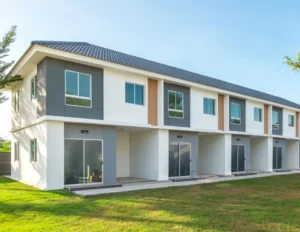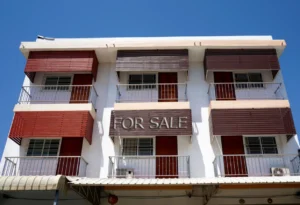The Growing Real Estate Insurance Crisis Has Its Day In The Senate
A broad consensus has formed that the U.S. housing industry is in an insurance crisis — and that solutions might not be easy to find.
The accelerating pace of climate change has increased the frequency of natural disasters across the country, not only driving up insurance premiums but making it more difficult overall to find coverage, according to testimony at a Senate Banking, Housing and Urban Affairs Committee hearing on Thursday.
 Insurers have pulled out of states with high levels of exposure to climate-related disasters such as California, Texas and Florida — the three most populous states in the union, National Church Residences Executive Vice President of External Affairs and Strategic Partnerships Michelle Norris testified. National Church Residences is a nonprofit owner of 360 affordable housing properties across 23 states.
Insurers have pulled out of states with high levels of exposure to climate-related disasters such as California, Texas and Florida — the three most populous states in the union, National Church Residences Executive Vice President of External Affairs and Strategic Partnerships Michelle Norris testified. National Church Residences is a nonprofit owner of 360 affordable housing properties across 23 states.
Climate change isn’t the only thing causing insurance premiums to rise dramatically, with inflation and high interest rates also pushing rates higher, but climate-driven disasters are the reason the Senate finally took notice, National Multifamily Housing Council Vice President of Government Affairs, Technology and Strategic Initiatives Kevin Donnelly told Bisnow in a telephone interview after the hearing.
“The high level of catastrophic events over the past several months has really put insurance availability and unavailability in Congress’ lap,” Donnelly said. “While [senators] may vary in their preferred policy solutions to it, they clearly hear about it from their constituents and are eager to find common ground on a bipartisan solution.”
Among the possible solutions mentioned at the hearing: a long-term reauthorization and reform of the National Flood Insurance Program, which is scheduled to expire at the end of September.
If NFIP is allowed to lapse, it would prevent new policies from being signed for one of the most important methods homeowners have for insuring their properties against floods, Consumer Federation of America Director of Insurance Doug Heller and R Street Institute Policy Director for Finance, Insurance and Trade Jerry Theodorou testified.
Another solution promoted by Heller and some senators who asked questions at the hearing was expanding and adding programs subsidizing proactive repairs and updates to make buildings more climate resilient. That would reduce the size of claims insurers have to pay out, easing upward pressure on premiums, Heller said in his testimony.
Trade groups like NMHC, the National Apartment Association and the Mortgage Bankers Association submitted public letters underscoring the urgency of the insurance crisis. In the first quarter, commercial property premiums increased by over 20%, the largest quarterly increase in 20 years, MBA Vice President of Legislative and Political Affairs Bill Killmer wrote in his letter.
A June survey by NMHC of its membership found that multifamily insurance costs rose 26% year-over-year. While premiums may be responsive to the size and number of claims an insurer deals with, the effects of economic pressures facing the real estate market over the past year-plus will likely take at least another year to fully manifest, Theodorou testified.
Private landlords are often characterized, as they were at multiple points during the hearing, as being able to pass along rising costs to their tenants. But only in the delirious rent increases of 2021 would landlords be able to pass along anything close to the cost of a 26% year-over-year increase in premiums, Donnelly said.
“It’s wildly unrealistic to assume that a private operator can just pass costs on to renters,” he said. “When looking at vacancy rates and supply issues, it’s a highly competitive market in which to just drop massive rent increases … Property owners do everything possible to avoid passing cost increases onto renters, and they often take on more risk to avoid these increases.”
Paying Too Much For Insurance?
Get a FREE quote to insure your rental properties for less.
One of the most contentious issues at the hearing was the question of who should bear the brunt of the cost associated with the growing impact of climate change. In addition to raising premiums or exiting markets, insurers are reducing the scope of their coverage and passing risks along to owners of both multifamily and single-family properties.
In NMHC’s June survey, 61% of members reported increasing their minimum deductibles to offset higher premiums, while 57% said their insurance carriers introduced new exclusions to their policies, shrinking the scope of covered damage. About 34% of respondents said their insurance coverage amounts decreased this year.
National Church Residences had four carriers to choose from when insuring its national portfolio in 2022, but this year was a different story, Norris testified.
“Three of those [carriers] walked away and left us with a single carrier, and basically a ‘take it or leave it’ on the premiums,” she said.
Without any relief, owners of both market-rate and affordable multifamily properties are forced to take cost-cutting measures like deferring maintenance and reducing resident services, Norris and Donnelly said. Deferred maintenance isn’t just among the most common responses to a cost crunch, it also makes claims much more expensive if and when those properties suffer damage.
Hurricane and wildfire season are still in full swing. The winter promises a different set of climate-based challenges like the 2021 winter disaster in Texas, which Heller testified was one of the most impactful events for insurance premiums in recent history. There is little doubt that the insurance crisis will deepen if current economic and regulatory conditions persist, the trio of speakers at Thursday’s hearing agreed.
“Because there is such a thirst for a public policy solution to this crisis, NMHC is in the early stages to try to identify that,” Donnelly said. “We’ve assembled a coalition of real estate groups who are representing the impacted [owners] to try to come up with a consensus policy solution to help us weather the storm.”
Source: Bisnow













 Accessibility
Accessibility